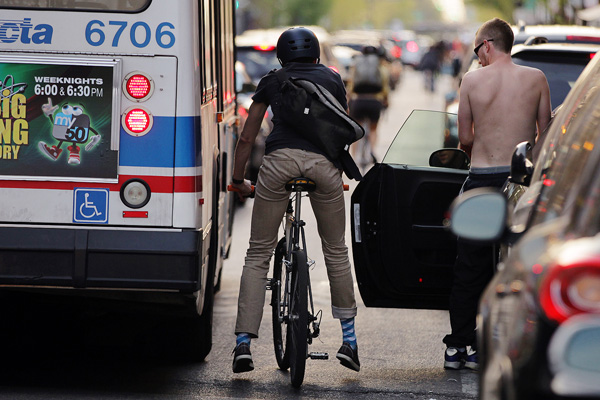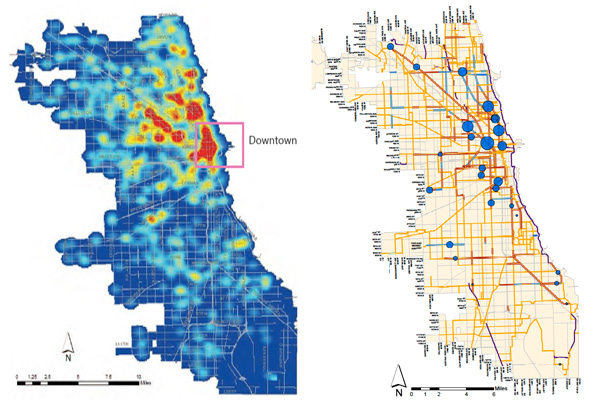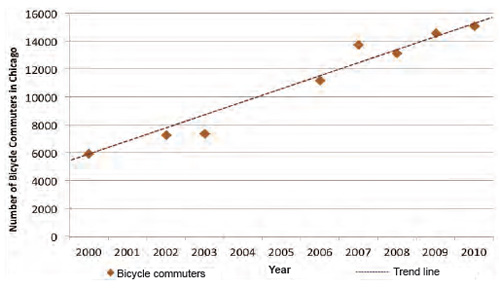
Photo: Terrence Antonio James/Chicago Tribune
Milwaukee Avenue, May 8, 2013
Via DNAInfo's Kyla Gardner, the City of Chicago released its 2012 bike crash report, and the results are about what you'd expect if you spend much time on the streets of Chicago. Wicker Park has the most bike crashes (70 per mile on the 7/10ths of a mile between North and Division on Milwaukee from 2005-2010). What's harder to tell is causation; it's also where cyclists are most likely to be in Chicago.

On the left are Chicago's bike-crash hotspots; on the right is a map from the last official city bike count, taken in 2009. At 640 N. Milwaukee—on what was, granted, a perfect day for biking, a September day with a mean temperature of 73 degrees and no precipitation—3,121 cyclists were counted over a 24-hour period. Compared to the city's 2006 average daily traffic count (not ideal, but it's the data the city has), that's a 21.90 percent mode-share, the equivalent of one-fifth of the traffic at that intersection. Two months later, on a crappier day for biking (42 degrees), the mode share was 15.8 percent.
The count also included 1616 N. Milwaukee, at the other end of the popular West Town-Wicker Park run. On an even worse day for biking (50 degrees, almost an inch of rain in early October), the mode share was 7.7 percent. That's almost identical to 1325 N. Wells Street on another perfect September day (7.8 percent mode share).
It's limited data, but it tracks with more recent volunteer tracking done by the Chicago Bicycle Program: during the rush hours on September 12, 2012, 1,138 bikes were counted from 7:00-9:00 AM and 903 from 4:00-6:00 PM at Elston and Milwaukee, numbers that surpass all downtown summer bike counts that year.
Does that make that stretch of Milwaukee one of the most dangerous, as Gardner asks? It's actually hard to say from the data. Diagonals have a lot of bike traffic (probably because they both make for efficient commutes and because they tend to be commercially dense, like with really good bars)
But they also make for what the report calls "complex intersections." And failure to yield by cars was the cause of 40 percent of bicycle injury crashes.
Crashes are up, according to the report, from 1,236 in 2005 to 1,566 in 2010, with an increase in the percentage of all injury crashes no matter the transportation mode: from about seven percent to about ten percent.
But it's not bad news, necessarily. The increase in cyclist injuries is close to, but not proportionally as high, as the increase in bicycle commuters.

And the infrastructure on that stretch of Milwaukee has improved significantly: bike lanes have been separated from traffic on much of that stretch of Milwaukee, with green-striped lanes in congested areas and safety changes to traffic lights:
Smith also said that traffic signals at Milwaukee and Ogden Avenue would be modified soon, bringing in a new “protected left turn” — in which northbound traffic will have a dedicated left-turn signal. This will eliminate the “yellow trap” seen at this kind of six-way crossing, in which turning drivers and bicyclists are caught in the middle of an intersection when their light turns red, while, unbeknownst to them, oncoming traffic still has a green. Two weeks ago I was on the wrong end of a yellow trap at this intersection and almost got broadsided by a motorist.
Milwaukee between Damen and North, however, remains a tight squeeze between traffic, parked cars, and bikes—which is why Steven Vance suggests it as a bikes-and-transit-only stretch.



